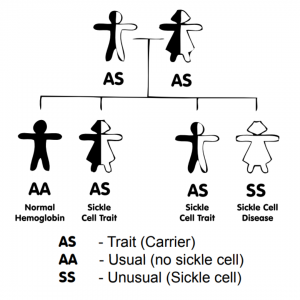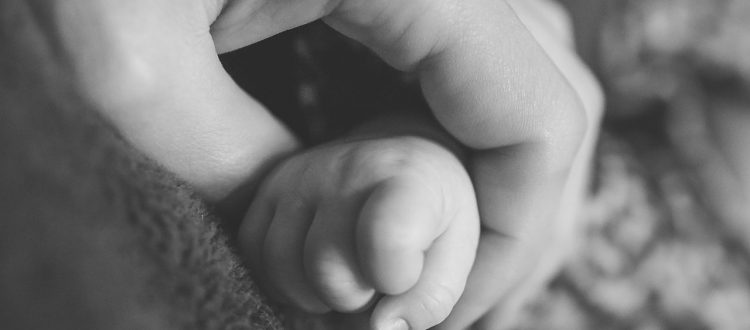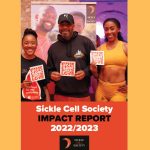Introduction to the Inheritance of Sickle Cell Anaemia
Everyone has two copies of the haemoglobin gene in every cell in their body (apart from eggs and sperm). They get one from their mother and one from their father. When eggs and sperm are made, only one of the two genes goes into each egg or sperm cell. This is so that when the egg and sperm come together to make a new baby this new person has two genes in every cell in their body as well. The genes the baby gets will therefore depend on the genes carried in its parents.
Sickle Cell Anaemia is called a recessive condition because you must have two copies of the sickle haemoglobin gene to have the disorder. Sickle haemoglobin is often shortened to S or HbS. If you have only one copy of the sickle haemoglobin along with one copy of the more usual haemoglobin (A or HbA) you are said to have Sickle Cell Trait. This is not an illness but means that you “carry” the gene and can pass it on to you children. If your partner also has Sickle Cell Trait or Sickle Cell Anaemia your children could get Sickle Cell Anaemia.
If you know the types of haemoglobin you and your partner have, you will know the different possible combinations of genes that your baby could inherit. Only when both parents are HbAA and/or HbSS will all your children inherit the same combination of genes so you can be sure whether your child will be affected or not.
Could my Children get Sickle Cell Anaemia?
You may find the following diagrams useful to help you understand how sickle haemoglobin is inherited. In all the following diagrams you will get the same possibilities if the genes in the mother and father are swapped over.
The lines coming in to each baby show that one gene has come from the mother and one gene has come from the father. In these diagrams the presence of the usual haemoglobin gene is shown by pink and the presence of the sickle haemoglobin gene is shown by blue.
The diagrams show the following combinations of parents and the types of children they can have:
- Sickle Cell Trait and Unaffected
- Sickle Cell Trait and Sickle Cell Trait
- Sickle Cell Trait and Sickle Cell Anaemia
- Sickle Cell Anaemia and Unaffected
If one parent has sickle cell trait (HbAS) and the other does not carry the sickle haemoglobin at all (HbAA) then none of the children will have sickle cell anaemia. There is a one in two (50%) chance that any given child will get one copy of the HbS gene and therefore have the sickle cell trait. It is equally likely that any given child will get two HbA genes and be completely unaffected.
It is possible to test an unborn baby for the type of haemoglobin it has. Go to the Prenatal Testing page for more details.
 If both parents have sickle cell trait (HbAS) there is a one in four (25%) chance that any given child could be born with sickle cell anaemia. There is also a one in four chance that any given child could be completely unaffected. There is a one in two (50%) chance that any given child will get the sickle cell trait.
If both parents have sickle cell trait (HbAS) there is a one in four (25%) chance that any given child could be born with sickle cell anaemia. There is also a one in four chance that any given child could be completely unaffected. There is a one in two (50%) chance that any given child will get the sickle cell trait.
It is possible to test an unborn baby for the type of haemoglobin it has. Go to the Prenatal Testing page for more details.
If one parent has sickle cell trait (HbAS) and the other has sickle cell anaemia (HbSS) there is a one in two(50%) chance that any given child will get sickle cell trait and a one in two chance that any given child will get sickle cell anaemia. No children will be completely unaffected.

It is possible to test an unborn baby for the type of haemoglobin it has. Go to the Prenatal Testing page for more details.
If one parent has sickle cell anaemia (HbSS) and the other is completely unaffected (HbAA) then all the children will have sickle cell trait. None will have sickle cell anaemia. The parent who has sickle cell anaemia (HbSS) can only pass the sickle haemoglobin gene to each of their children.
It is possible to test an unborn baby for the type of haemoglobin it has. Go to the Prenatal Testing page for more details.
Understanding Chance
To help you to think about chance it can be useful to use things that we are all used to. When a woman has a baby there is a one in two (50%) chance that the baby will be a girl and a one in two (50%) chance that the baby will be a boy. Although over the whole population there are almost exactly equal numbers of men and women, within any family there may be all girls, all boys or a mixture of both.
The one in two chance applies to each pregnancy afresh. The one in two chance just tells you that nature will choose one out of two different possibilities. If the chance is one in four, there are four different possibilities and the outcome will be one of these. This is very important in understanding what sort of children you will have if you carry the sickle haemoglobin gene.
For example, if there is a one in four chance that you will have a baby with sickle cell anaemia, and if you go on to have a number of children, it is still possible that all your children could have sickle cell anaemia or that none will have sickle cell anaemia.









